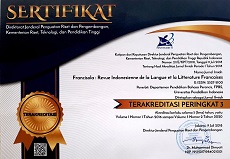Lexical and pragmatic strategies in depicting grief in Ernaux’s "La Place" and "Une Femme"
Abstract
This study explores the pragmatic and stylistic representations of death and grief in Annie Ernaux’s modern French novels, La Place and Une Femme. Employing a qualitative textual analysis with a pragmatic-stylistic approach, the research examines selected excerpts to identify speech acts, deictic elements, and stylistic features that convey emotional depth and social context. Through close reading and coding based on Austin’s and Searle’s speech act theories, Levinson’s deiksis, and principles of pragmastylistics, the analysis reveals Ernaux’s minimalist “flat” writing style. This style, characterized by direct and unembellished language, juxtaposes death with mundane routines, enhancing emotional resonance and authenticity. The findings demonstrate how Ernaux’s linguistic and stylistic choices effectively depict the complexities of grief, reinforcing the significance of pragmastylistic analysis in understanding autobiographical literature.
Keywords: autobiographical literature; Ernaux; grief; pragmastylistic; French novel
Full Text:
PDFReferences
Alavai, F., & Gholami, F. (2015). «Moi» et ses voix à travers le regard des autres Etude Selective - La Place d’Annie Ernaux, Le Moi de l’autre de Reza Amir Khani. Revue Des Études de La Langue Française, 7(1), 13–25.
B., A. (1984, November 13). RENAUDOT : Annie Ernaux pour “la Place” Une romancière de la déchirure sociale. Le Monde. https://www.lemonde.fr/archives/article/1984/11/13/renaudot-annie-ernaux-pour-la-place-une-romanciere-de-la-dechirure-sociale_3138375_1819218.h
Black, E. (2006). Pragmatic Stylistics (Edinburgh textbooks in applied linguistics). Edinburgh University Press.
Bocci, V. (2019). Du roman familial au transfuge de classe, la question de lídentité. Cahiers de Psychologie Clinique, 52(1), 105–132.
Develey, A., & Clermont, T. (2022, October 6). Annie Ernaux, première Française prix Nobel de littérature. https://www.lefigaro.fr/culture/le-prix-nobel-de-litterature-attribue-a-la-francaise-annie-ernaux-20221006
Dreux, G. (2022, October 13). “Quelque chose entre la littérature, la sociologie et l’histoire” Annie Ernaux. Questions de Classe(s). https://www.questionsdeclasses.org/quelque-chose-entre-la-litterature-la-sociologie-et-lhistoire-annie-ernaux/
Edwards, N. (2022). Gender and generation: Elena Ferrante, Annie Ernaux and the legacy of Simone de Beauvoir. Romance Studies, 40(3–4), 180–194.
Ernaux, A. (1983). La Place (Folio). Gallimard.
Ernaux, A. (1987). Une Femme. Gallimard.
Ernaux, A. (2022). Conférence nobel par Annie Ernaux lauréate du prix Nobel de littérature 2022. In La Fondation Nobel.
Francequin, G., & Valmorin, C. (2017). de Gaulejac, V. La névrose de classe. Trajectoire sociale et conflits d’identité suivi d’une lettre d’Annie Ernaux. L’Orientation Scolaire et Professionnelle, 46(1).
Garaud, C. (1994). Écrire la différence sociale: registres de vie et registres de langue dans La Place d’Annie Ernaux. French Forum, 19(2), 195–214.
Granereau, S. (2024). L’Anatomie du réel. Le récit de deuil chez Annie Ernaux : une poéthique du récit d’orphelinage. Littératures, 89, 281–293.
Hauer, C. (2021, July 20). Lundi librairie : Une femme - Annie Ernaux. Paris La Douce. https://www.parisladouce.com/2021/07/une-femme-annie-ernaux.html
Johnson, W. (1999). The dialogic self: Language and identity in Annie Ernaux. Studies in 20th & 21st Century Literature, 23(2).
Mahmoud, R. H. (2023). Hasan Aydin Identity construction and speech acts in Ernaux’s The Years. Journal of Ethnic and Cultural Studies, 10(5), 172–188.
McIlvanney, S. (2001). Annie Ernaux: The return of origins. Liverpool University Press.
Mihelakis, E. (2010). Comprendre et faire comprendre le deuil de la mère dans Une femme d’Annie Ernaux. M@gm@, 8(1).
Moricheau-Airaud, B. (2021, January 8). « Vie, vieillesse et mort d’une femme du peuple » : « ni une biographie, ni un roman naturellement, peut-être quelque chose entre la littérature, la sociologie et l’histoire ». Fabula / Les Colloques, « Lectures Sur Le Fil ». https://www.fabula.org/colloques/document11524.php
Parayre, C. (2008). Récits de deuil : Annie Ernaux et Jean-Noël Pancrazi témoignent. Dalhousie French Studies, 82, 173–179.
Peszat, R. (2012). The language of flowers in Annie Ernaux’s Une Femme. Women in French Studies, 20(1), 32–46.
Searle, J. R. (1975). A taxonomy of illocutionary acts. In Language, mind, and knowledge (Vol. 07, pp. 344–369).
Sirvent Ramos, Á. (2024). Le poids des mots dans l’œuvre auto-socio-biographique d’Annie Ernaux. Thélème, 39(2).
Toutounchian, F., & Nassehi, Z. (2014). Une Femme d’Annie Ernaux : de la subjectivité d’une écriture objective. Études de Langue et Littérature Françaises, 2(9), 91–110.
Usman, R., Abbas, H., Amir, M. P., & Sahib, H. (2024). Inner Conflicts in “Happening” Novel by Annie Ernaux: An Overview of Literary Psychology. Proceedings of the 4th International Conference on Linguistics and Culture (ICLC-4 2023), 349–353.
Yücedağ, S. (2017). Une Nouvelle Forme d’Autobiographie dans Les Années d’Annie Ernaux : Autobiographie Impersonnelle. Selçuk Üniversitesi Edebiyat Fakültesi Dergisi, 38, 381–392.
DOI: https://doi.org/10.17509/francisola.v10i1.78825
Refbacks
- There are currently no refbacks.
Copyright (c) 2025 FRANCISOLA

This work is licensed under a Creative Commons Attribution-ShareAlike 4.0 International License.
View My Stats











